Chile, March/April 2024
I was due for my routine trip to Winnipeg in Spring/Summer of 2024, and was wondering what additional destination(s) I could tag onto this journey. Winnipeg friends Erica and Julio have a property in Coquimbo, Chile, and they'd been hounding us for ages, "When are you going to come to Chile and stay with us?" Well, how about right now? The plan would be for me to fly from Sydney to Chile, meet Maggie coming from Winnipeg, spend a month or so visiting with our friends, and thence onward to Canada. We would stay for a couple of days with our other friends Luis and Fedalisa in Santiago, before proceeding on to Coquimbo for most of the remainder of out visit.
I flew into Santiago, Chile, on 12 March, and met Maggie as scheduled at our L&F's home in Santiago. We would be honoured guests with this charming couple that we knew also from Winnipeg. Luis and Fedalisa, our treasured Santiago hosts, wined and dining us in gracious elegance, took us around to get sim cards and onward bus tickets to Coquimbo where Erica and Julio lived, and showed us around the sights and atmosphere of central Santiago. Santiago is not renowned as a must-see destination, but is a pleasant enough city, with a reasonable collection of sites and attractions.
Luis showed us around one of the main squares, the Plasa de la Constitucion, surrounded by government and legal ministries and the presidential residence Palacio de la Moneda. Luis, along with Fedalisa, Julio and Erica, were all survivors of the 1973 coup and subsequent Pinochet era, and was a wealth of information and insights into this horrific era in Chile's history. He gave a good running commentary of the historical and political aspects of the square and Chile in general, including the 1973 coup, the assassination of Salvatore Allende in the palace, and rise of Augusto Pinochet.
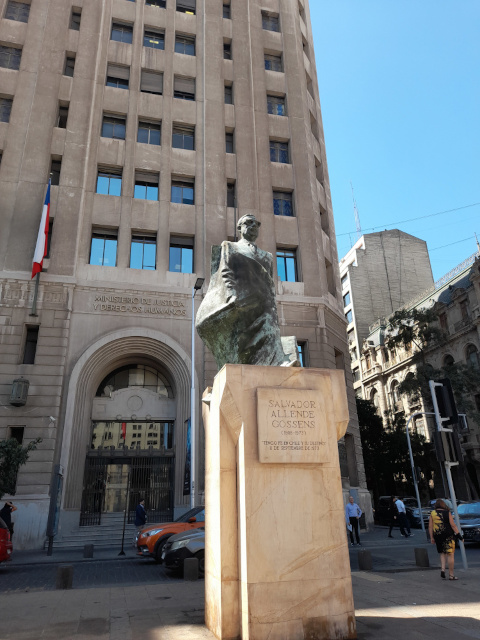
Allende statue, Plasa de la Constitucion
Nearby are bustling pedestrian streets, with vibrant market stalls and crowds of shoppers and tourists.
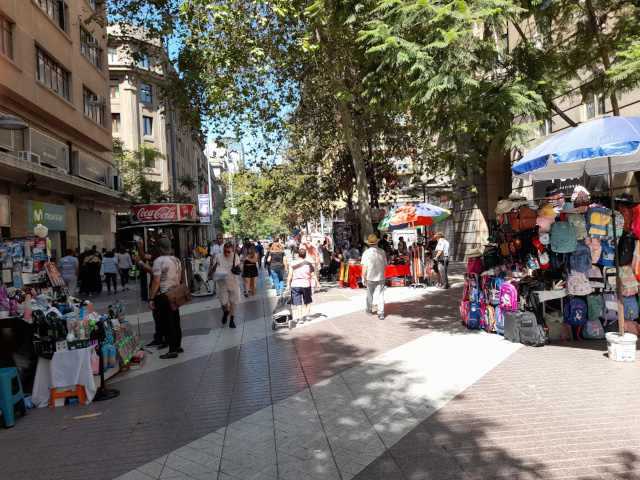
Huerfanos pedestrian streets, Santiago
Slightly farther on is the park-like main square Plasa de Armes, with its impressive array of statuary and surrounding architecture. Easily the most impressive structure is (perhaps inevitably owing to the dominance of the Church in Latino culture) the Catedral Metropolitana de Santiago de Chile.
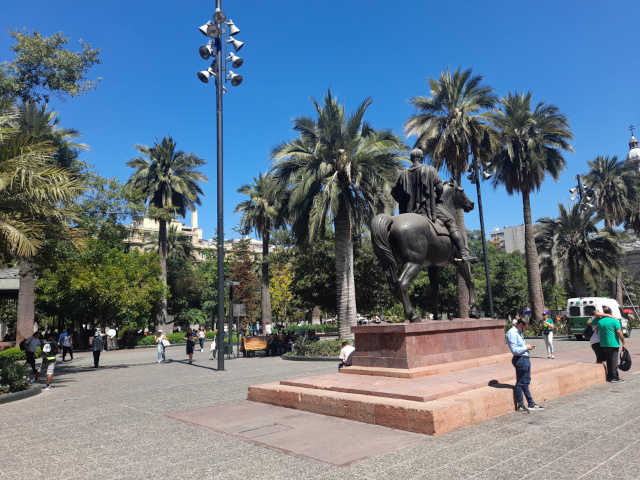
Plasa de Armes
Slightly north of the centre one can walk up through the "Bohemian Quarter" Bellavista. It's the restaurant/bar/nightclubs district, but predictably quiet-and maybe not all that safe-at this time of day.At the north end of Bellavista is the Cerro San Cristobal hill. One can take a funicular railway up to near the top of the hill, or walk up; one guess which method we chose! Slightly above the funicular was the mirador (viewpoint) area, at which Mag and Luis stopped. Here were good views over Santiago, slight haze making nearby views OK but distant hills nearly invisible.
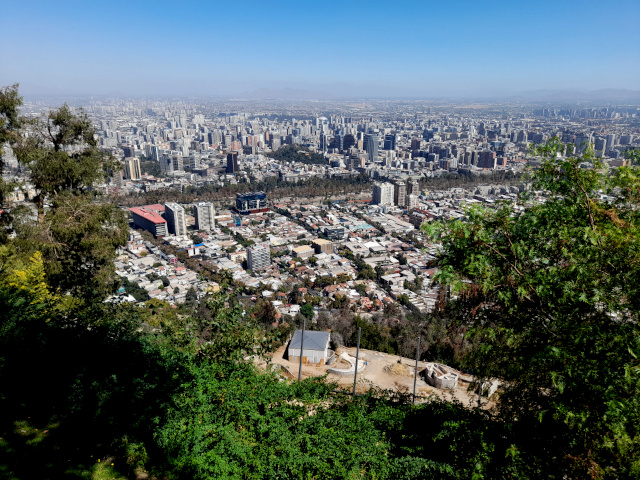
Santiago view from Cerro San Cristobal
I continued up even more stairs to the very top, where stood the beautiful Virgen de la Immaculate Conception statue and chapel, and even more magnificent vistas over the city and surrounds.
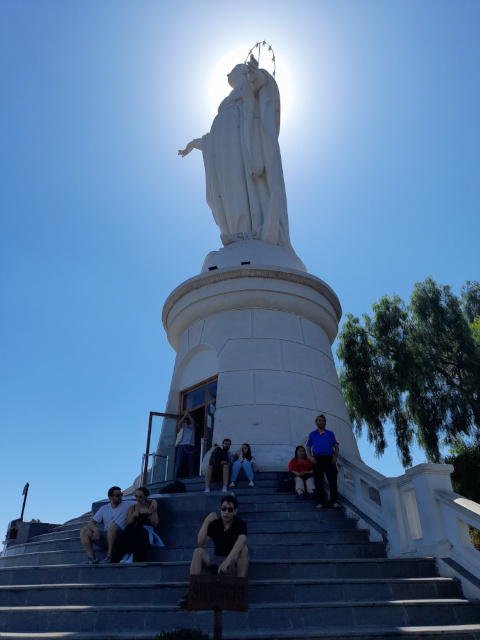
Virgen de la Immaculate Conception. Did I get the aura right?
After only a couple of days in Santiago, Luis drove us to the bus station where we caught the 11:30 bus to Coquimbo, about 4-5 hours drive north of Santiago. It was a pleasant trip, travelling through dry semi-barren rolling countryside and small towns and villages, large arid hills in the distance and some ocean views with big surf. My favorite pastime on these rides is to watch the scenery while listening to music and podcasts on my phone.
Julio and Erica met us, and we would have the next 4 weeks or so soaking up their hospitality and entertainment management. They have a house (in addition to their Winnipeg residence) here in Coquimbo, about 1/2 km away from the magnificent Coquimbo Harbour and la Herrudera Beach.
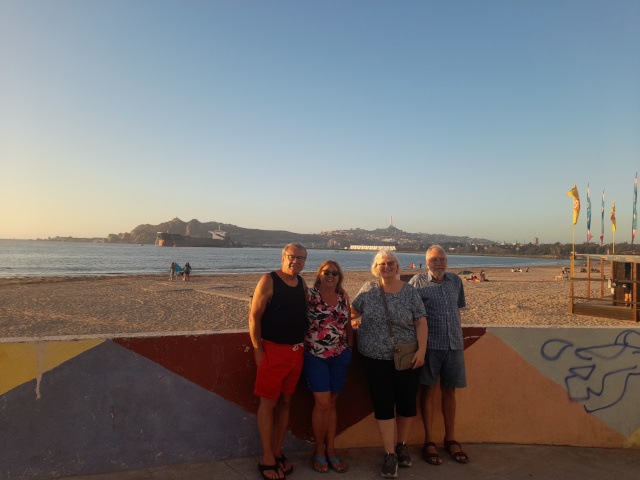
Julio, Erica, Margaret and Sanford at la Herrudera Beach
We would spend hours in the next few weeks walking and exploring along the beach (beautiful sunsets) and surrounding headlands and suburbs. We walked or took a bus to various markets and shops to stock up on vegetables, fruit, meat and fish, and to supermarkets for groceries and the all-important beer/wine/drinks. A number of walking trips were to "downtown" Coquimbo, to visit the mall, the main bus station to get tickets or board a bus, or to explore the fish market, souvenir stalls, foreshore, a couple of kitsch-looking pirate-themed tour boats, and a moderately interesting CBD.
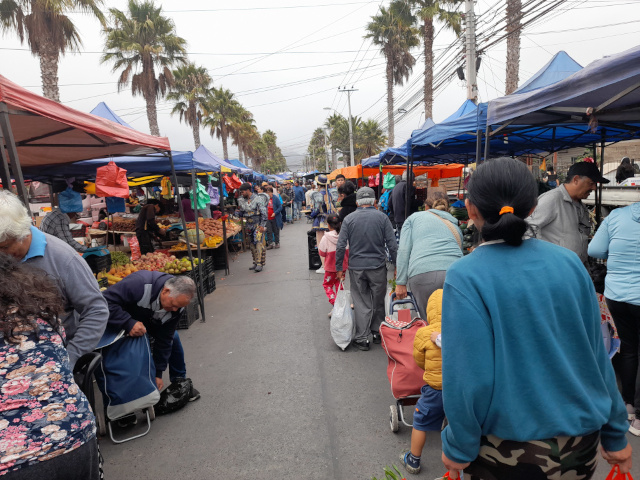
Coquimbo weekly market
One excursion was to downtown La Serena, Coquimbo's nearby larger "neighbour city". We explored a number of unspectacular but pleasant city streets, the large San Juan market (mainly souvenir/craft-type) complex, the park-square 4 Estaciones, semi-historical buildings with distinctive architecture, and finally the large same-as-any-city Mall Plaza la Serena.
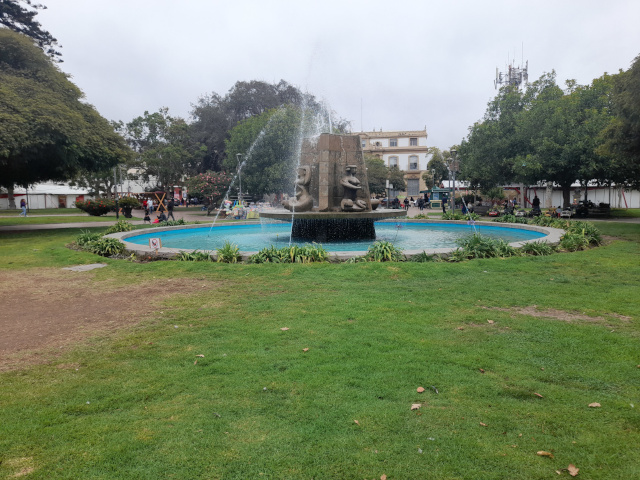
4 Estaciones Park, La Serena
The region is not necessarily safe nor crime free, and most residences are protected by spikes or barbed wire, but we rarely felt threatened or unsafe. People are generally friendly and courteous, always greeting with a "Buen dia!", a smile and even conversation. Weather varied between slightly hot and slightly cool, with little or no rain - Chile is suffering severe drought at the present. The beach itself is somewhat grubby, with a large quantity of seaweed washed up and starting to rot. During tourist season they clean it up, but now it's left there to wash away or decay. Some of the offshore seaweed is harvested, dried and sold to Japan, presumably for sushi wraps.
I had decided to get away on my own for a few days and travel up to San Pedro de Atacama, in the far northwest of Chile. I'd been there before, in 2007, and had found it such an interesting place that I wanted to get back again. I boarded the bus from Coquimbo station and left at 17:00 on 24 March, for what would be a reasonably comfortable (I even slept on the bus for a while) 30-hour journey. It passed through through stunning scenery of dry mountains, switchback ascents and some coastline, stopping near dawn in Antofagasta before continuing on to the desert town Calama in the east around 09:00. It seemed most of the passengers on the bus were fit young guys, probably going to the mines to work, and getting off anywhere from Antofagasta to Calama and parts in between.
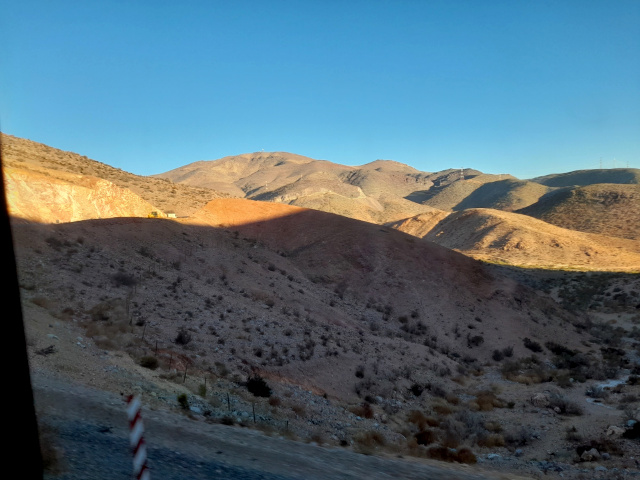
Climbing up somewhere north of La Serena
I had to wait for over an hour for a bus to San Pedro de Atacama, but the trip there was not much more than an hour or so, followed by a short walk to my basic but comfortable accommodation. I spent the first afternoon and evening exploring around the town centre, checking out shops and eateries, and arranging for bike hire. SPDA is a major tourist town, and geared up well for that role; along the main drag every second shop appeared to be a tour agent.
Having been here before, I'd already been to the main attractions of Vale de la Luna, Vale de Marte and the ruins Pukara de Quitor (see my website for details of that trip). This time, knowing that there were bicycles to rent here, I resolved to ride to some of the lesser known attractions accessible by bike.
Next day, I had secured a good mountain bike with helmet, vest and lock. About 08:25 I started riding north along the road near the river bed. I bypassed the Pukara de Quitor, having seen it in 2007. At about 3 km from town was the entrance track to the Qubrada del Diablo canyon. On this track you ride along a relatively flat and easy creek bed for a few km and up to the start of a climb to a hill/cerro/mirador.
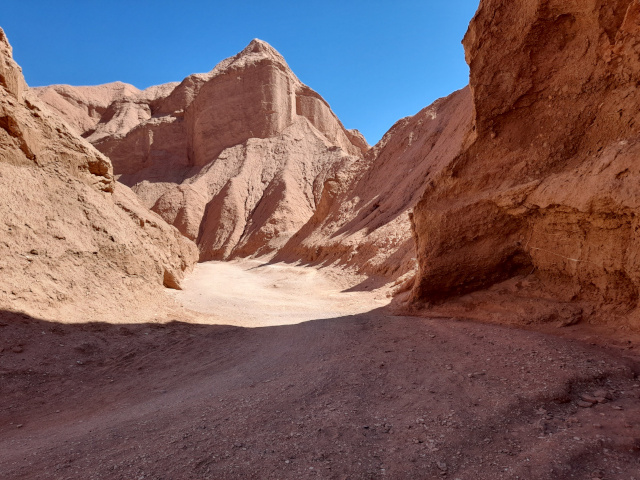
In the Qubrada del Diablo canyon. Spectacular and easy biking
It was a truly amazing ride, stunning orange/red/pink walls, rock overhangs, cliffs, and only a couple of places where I had to carry the bike over steps. The Diablo Mirador was a considerable walk up; I was hesitant to do it, but slowly and eventually went all the way to the 2684M summit, and was rewarded with a magnificent 360 of hills, mountains, valleys, rocky plains and views all the way back to the river and the town. Soooo worth it!
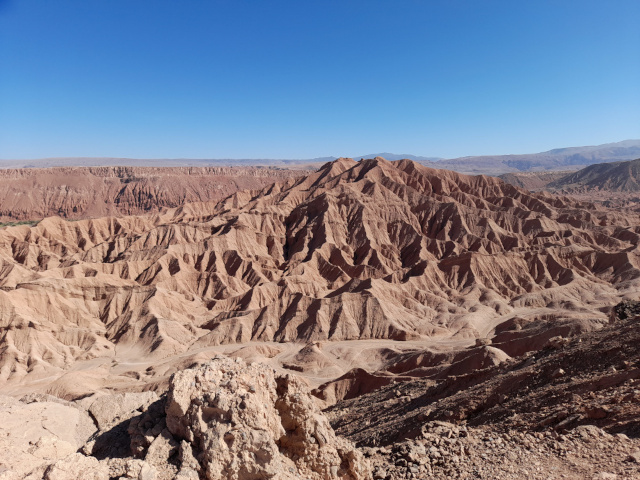
Only a small part of the view from the Diablo Mirador
Back down to the road, I continued riding several km more up the river to the Catarpe area, trying to find a church that I was told about. I had trouble locating it, but eventually found the lonely Capilla de San Isidro with its little bell tower and cross. I returned the bike (hasta manyana) around 13:00, after what was a truly spectacular morning.
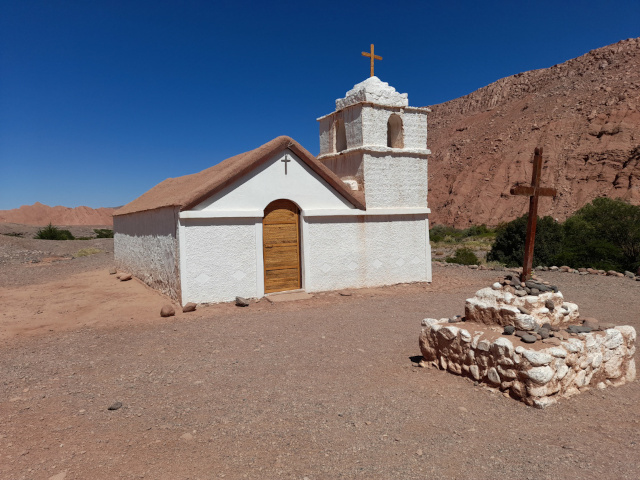
Capilla de San Isidro
It NEVER rains in the Atacama Desert; that's why there's surface salt deposits all over the place. But that afternoon it ROARED down for an hour or two, leaving large puddles and mud everywhere, and even closing the Vale de la Luna next day due to flooding. I wondered what it would do to the salt deposits, but someone assured me that these (approximately annual) rain events don't have a permanent effects.
Next day, 27 March, I had my bike back for another 1/2 day. This time I would go south, to find inter alia the Aldea de Tulor ruins. Getting away at 08:45, my phone map suggested I take a tortuous route through city streets to get south, but I thought it would be much easier to take the ring road around from my place. It was quite an quick and easy route, but as I was nearing the turnoff for Tulor, I came upon a small memorial shrine next to the road, with a cross, flowers and a wrecked bike. Maybe this wasn't the safest option (??)
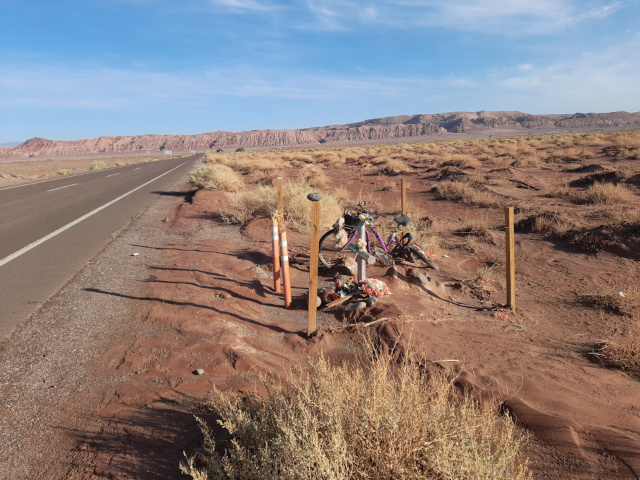
Bike memorial on side of San Pedro ring road. Should I be cycling here?
In contrast to the rocky hilly stony ride yesterday, this ride was very smooth roads and flat desert. I got to the Aldea de Tulor ruins site in good time.
We can't go in to the ruins on our own, must go with a tour guide. She took us into a couple of huts where she went through a session explaining the history (I think from the mesolithic era, 380BCE to 200CE), culture and agriculture of the inhabitants and wildlife in the area. The talk was all in Spanish, but I picked up parts of it. We had to walk some distance to the ruins themselves, and the guide showed us various desert plant species along the way and their uses.
The ruins themselves consisted of a couple of replication huts built of mud brick and wood/straw, and the location of the ruins themselves. The ruins consisted of what looked like a 20 metre square layout of foundations of homes and storage bins. All not very big-time, but interesting nonetheless.
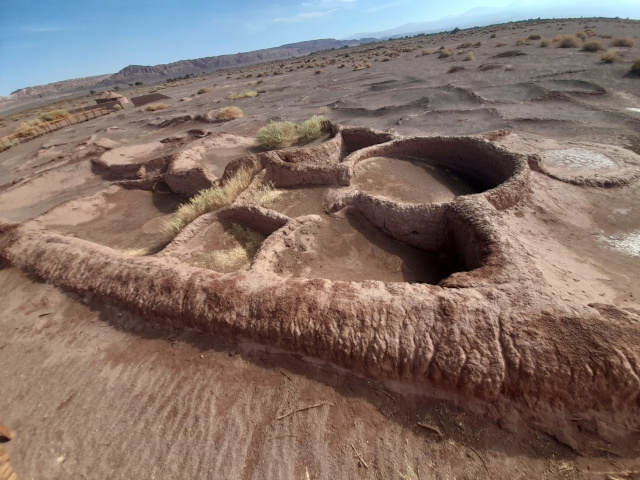
Village ruins, Aldea de Tulor
It was only about 10:30 as the tour finished. Too early to go back, I knew of the village Tulor a bit south and beyond that maybe a large salar (salt) lake, Lagos Tebenquiche or something like that. So I rode south, along good smooth roads, past the village (nothing there except barking dogs), and on as far as the road went. To the south far in the distance was the lake, but I couldn't see much of it from where I was.
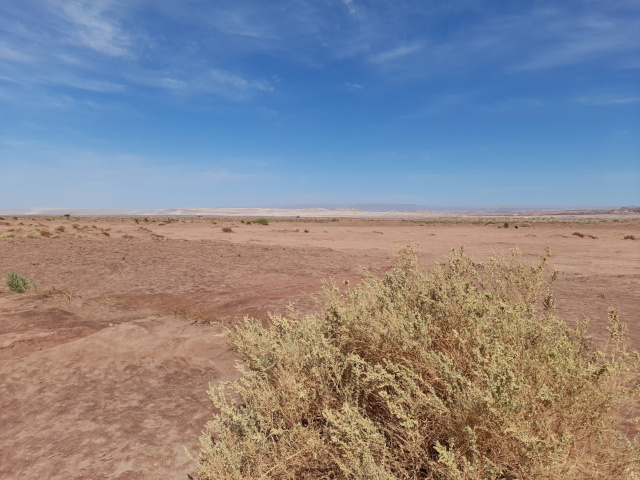
Salar lake Tebenquiche somewhere in the distance
I rode back to the ring road, and then tried another slow and bumpy road back, via the southern edge of town. As I was going through southern parts of the town, it struck me how dry, grubby and junky the place was, reminding me of Lightning Ridge, Australia.
Another get-away that Maggie and I did together was a 2-night trip to the tourist town Vicuna in the Elqui Valley. Leaving Coquimbo on 2 April, we boarded a bus at 12:15 for a 1-2 hour trip up the pretty but unspectacular Elqui Valley with its cactus-covered hills. Our accommodation hosts spoke little English, but we communicated well, and had everything we needed.
Vicuna is a charming place, quaint easily walkable streets, shops, restaurants and a pleasant central park/plaza that invites relaxation and chilling-out. Curiously, it seems every third shop is a barber or hairdresser, and they're all busy at all hours.
I had wanted to come here because Chile is world-renowned for observatories, and Vicuna is near one of the main ones, Mamalluca. We arranged for an observatory tour for our first evening. Leaving the plaza at 20:30, we drove in darkness north-east out of town several km, finally ending at the "observatory", at 1080M altitude (the town is 625M).
The site isn't really an observatory (the real ones are on surrounding mountain tops) but more a tourist site, with a non-functional planetarium, some museum-type exhibits/displays, and a Meade telescope on the roof. The guide talked in not-great English and not-great speaking talent about general astronomy, pointed out stars and constellations, showed guests various celestial objects through the telescope, and answered questions from the people. I was not impressed with the sky, maybe not high enough and maybe too close to town, the Magellan clouds barely visible; I'd seen better in western NSW. It was interesting though and I saw some new celestial objects and learned a few new things. It was cool up there but not really cold.
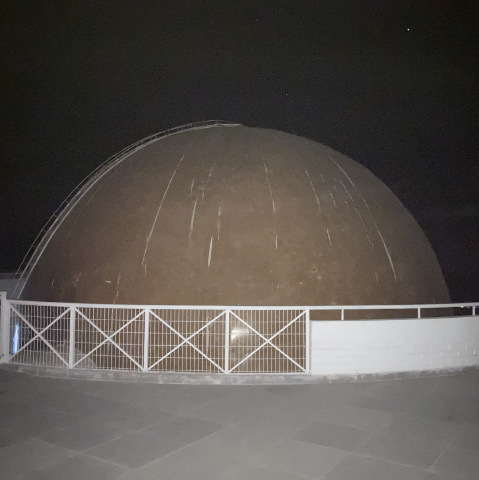
Planetarium dome, Mamalluca Observatory
Next morning, 3-4 km away to the north-east, is the , about a 1.5 hour walk from home. We decided to try that walk in the morning before it's too hot. We set out walking north around 09:30. It was a flat easy walk up the street to the cemetery, then it got steep and sandy/rocky. Maggie wasn't going to go up, and nearly stopped, but persisted and eventually got nearly all the way up to the upper level. Amazing! I continued up to a hilltop near the mirador communications towers but, not interested in a steel forest, didn't bother to go all the way. It was great up there, about 725M altitude, with wonderful views of town, farmland, hills and hilltop observatories. There were a few other people around, on foot or horseback. We came back down (more treacherous than up) and back to home about 11:30. Very worthwhile achievement!
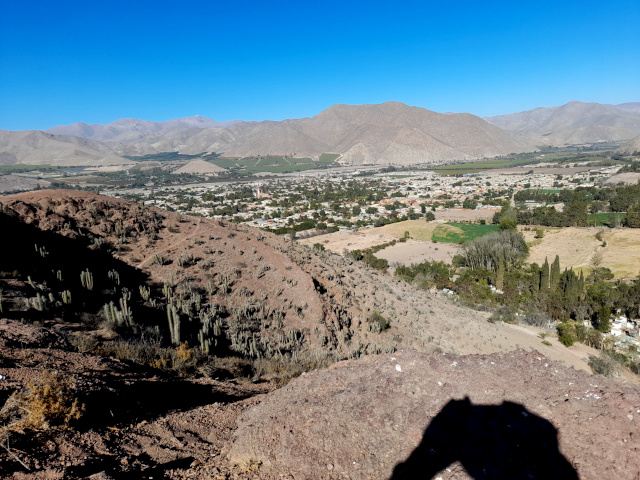
View over Vicuna from near Cerro de la Virgen
Around 18:00 we walked to a nearby pub/restaurant and had a birthday meal for Maggie; beer and rum/Coke and a couple of pizzas, quite a pleasant outing. In the evening we wandered around the Plaza de Vicuna and sat chilling out and soaking up the atmosphere. Vicuna is truly a charming ambient place. Next day, 4 April, we headed back to Coquimbo and to Erica and Julio. One activity for the four of us was to walk along the beach and on to the other side of the bay. Julio and I walked through I think La Herradura suburb, up a steep road onto a ridge and to the other side of the peninsula. It was quite a steep walk, but the views were worthwhile. This area was quite open and desolate, populated by rocks, dirt and cactus, but many new fancy homes were being built here, probably with drug/corruption money.
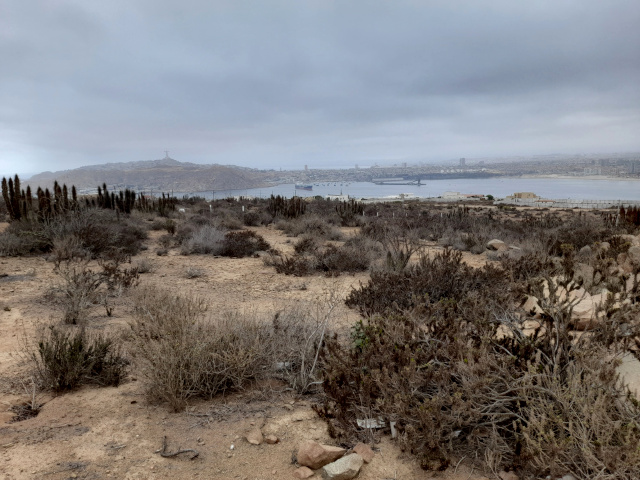
Open country, La Herradurra. Fancy houses to go up amongst the cactus and scrub
One day I heard drumbeats up the street somewhere. Going up to investigate, we found that an indigenous parade and performances were taking place just a few blocks away. A number of indigenous groups were performing traditional music and dance in their distinctive costumes, one group followed by another. Quite colourful and exciting. It was all very attractive, but we were told the performances would go on until about 19:00, so we left for home after the third dance.
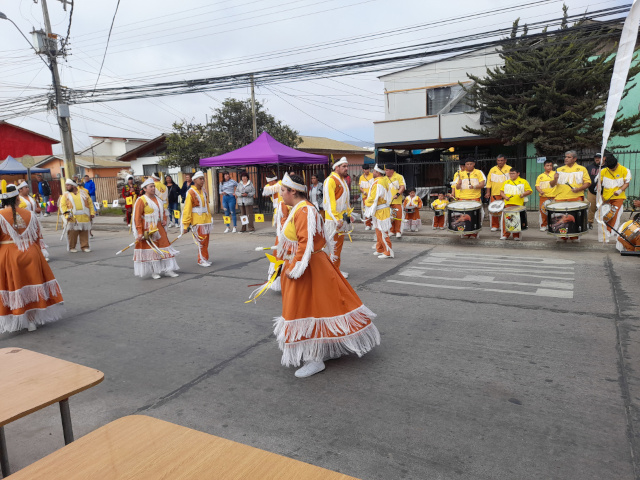
Indigenous parade and dance, Coquimbo
On 10 April Maggie and I were on a bus back to Santiago, where we again met and stayed with Lius and Fedalisa. But we were there only one night, as we were to fly out to Canada late the next day.
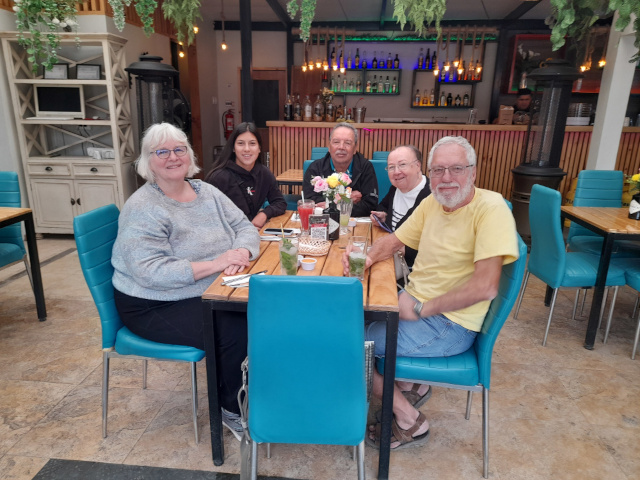
Dinner out; Margaret, Martina, Luis, Fedalisa and Sanford
At the appropriate time on 11 April amid sad goodbyes, Luis drove us to the airport, we were on the plane at nearly midnight, and on to Bogota, Toronto and Winnipeg for a nearly 24-hour flight including stops. Apart from difficulty retrieving our luggage in Toronto, all went well. It's interesting that there's a large difference in flight ticket prices here, depending whether you have checked luggage or not; as much as hundreds of dollars. Therefore it seemed that most passengers take all there luggage as cabin, even suitcases etc much bigger than my checked backpack. The in-cabin storage is therefore crammed full.
Nice to be back in Winnipeg. All-in-all, it was a great 1-month trip to Chile. Lovely to be able to stay with friends and get shown around and "entertained" and to get out by ourselves as well. Chile is a safe, amiable destination, not necessarily cheap but easy and pleasant.
